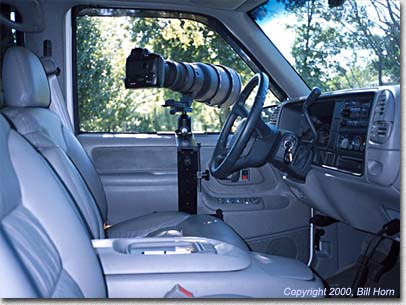|
|
 Camera Equipment Review... GROOFWIN Pod
Text Copyright and Photography Copyright Bill Horn
For lenses in the 200mm and under range, bracing against the car’s window frame may suffice to eliminate camera shake. Bigger lenses will require more support. I have found the best way to stabilize my F5/600mm rig is by using a specially made car-mount sold by L.L. Rue Enterprises. The GROOFWIN POD (Ground-Roof-Window) is a versatile, yet stable platform for holding a tripod head and camera/body combo. It is made from black anodized aluminum, weighs only 2 5/8 lbs., and is only 11” x 3”, making it small enough to fit in my suitcase when traveling by plane. Supported by three large rubber pads, it can be used in the flat position at ground level, or placed on the vehicle hood, or roof. A threaded knob secures the two sections tightly together whether in the flat position or mounted in the car window. In the field: How steady is this rig? As previously stated, I often use the GROOFWIN with a 600 F4 and 1.4x set on an Arca-Swiss B1 ball head mounted to the driver’s side window of my Chevrolet Tahoe. Setting up or taking down the unit between locations takes less than two minutes. Make sure the knurled knob, which locks the unit against the door panel, is secure, especially when using long lenses. Using the GROOFWIN to photograph birds from my vehicle enables me to get much closer than by foot. Anyone who has tried to photograph birds knows how tough they can be to approach, but using the GROOFWIN helped me get this image of the Eastern Meadowlark, shown singing away on an old fence post. He allowed me to pull within 20 feet. As he continued to sing, I exposed an entire roll of Provia F. Birds, and other wildlife, normally reluctant to assimilate to the proclivities of man, have become acclimated to the sight of vehicles, accepting them as a part of their daily lives. From a car, animals can often be approached to within a few yards without getting spooked. The GROOFWIN POD is a winner as far as I am concerned. It has allowed me to get images I could not have made otherwise. Additional information about the GROOFWIN and other photo accessories can be found on the When using a window mount, I strongly recommend turning off the car's engine to eliminate vibration. Keep in mind some flexibility is lost when shooting with a window-mounted camera, especially at upward angles. Also, shooting from a motor vehicle presents different criteria compared to taking images by traditional means. NPN offers the following guidelines on photography from a vehicle for safety and preservation of the environment:
You will be surprised how much you can see and safely photograph from your vehicle this way! BH-NPN |
|
|
 As nature photographers, we all share a common desire - spotting interesting subjects in our viewfinders. Natural habitat is shrinking to make way for more homes and shopping centers. Many popular nature photography locales are so crowded with tourist activity, making good images is nearly impossible. One of my favorite ways to beat the crowds is to shoot from my vehicle, along the back roads and lesser-traveled venues. Most parks and wildlife refuges now have an observation drive; a loop or turn-out whereby the public can both view and photograph nature’s beauty without ever leaving their automobile.
As nature photographers, we all share a common desire - spotting interesting subjects in our viewfinders. Natural habitat is shrinking to make way for more homes and shopping centers. Many popular nature photography locales are so crowded with tourist activity, making good images is nearly impossible. One of my favorite ways to beat the crowds is to shoot from my vehicle, along the back roads and lesser-traveled venues. Most parks and wildlife refuges now have an observation drive; a loop or turn-out whereby the public can both view and photograph nature’s beauty without ever leaving their automobile.